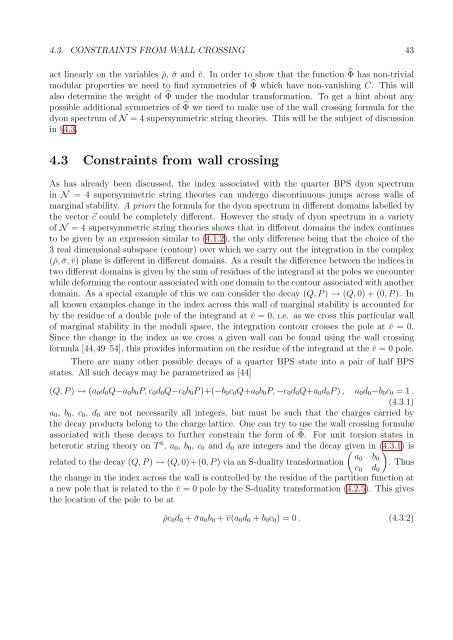PHYS08200604018 Shamik Banerjee - Homi Bhabha National ...
PHYS08200604018 Shamik Banerjee - Homi Bhabha National ...
PHYS08200604018 Shamik Banerjee - Homi Bhabha National ...
Create successful ePaper yourself
Turn your PDF publications into a flip-book with our unique Google optimized e-Paper software.
4.3. CONSTRAINTS FROM WALL CROSSING 43<br />
act linearly on the variables ˇρ, ˇσ and ˇv. In order to show that the function ̂Φ has non-trivial<br />
modular properties we need to find symmetries of ̂Φ which have non-vanishing C. This will<br />
also determine the weight of ̂Φ under the modular transformation. To get a hint about any<br />
possible additional symmetries of ̂Φ we need to make use of the wall crossing formula for the<br />
dyon spectrum of N = 4 supersymmetric string theories. This will be the subject of discussion<br />
in §4.3.<br />
4.3 Constraints from wall crossing<br />
As has already been discussed, the index associated with the quarter BPS dyon spectrum<br />
in N = 4 supersymmetric string theories can undergo discontinuous jumps across walls of<br />
marginal stability. A priori the formula for the dyon spectrum in different domains labelled by<br />
the vector ⃗c could be completely different. However the study of dyon spectrum in a variety<br />
of N = 4 supersymmetric string theories shows that in different domains the index continues<br />
to be given by an expression similar to (4.1.2), the only difference being that the choice of the<br />
3 real dimensional subspace (contour) over which we carry out the integration in the complex<br />
(ˇρ, ˇσ, ˇv) plane is different in different domains. As a result the difference between the indices in<br />
two different domains is given by the sum of residues of the integrand at the poles we encounter<br />
while deforming the contour associated with one domain to the contour associated with another<br />
domain. As a special example of this we can consider the decay (Q, P ) → (Q, 0) + (0, P ). In<br />
all known examples change in the index across this wall of marginal stability is accounted for<br />
by the residue of a double pole of the integrand at ˇv = 0, ı.e. as we cross this particular wall<br />
of marginal stability in the moduli space, the integration contour crosses the pole at ˇv = 0.<br />
Since the change in the index as we cross a given wall can be found using the wall crossing<br />
formula [44,49–54], this provides information on the residue of the integrand at the ˇv = 0 pole.<br />
There are many other possible decays of a quarter BPS state into a pair of half BPS<br />
states. All such decays may be parametrized as [44]<br />
(Q, P ) → (a 0 d 0 Q−a 0 b 0 P, c 0 d 0 Q−c 0 b 0 P )+(−b 0 c 0 Q+a 0 b 0 P, −c 0 d 0 Q+a 0 d 0 P ) , a 0 d 0 −b 0 c 0 = 1 .<br />
(4.3.1)<br />
a 0 , b 0 , c 0 , d 0 are not necessarily all integers, but must be such that the charges carried by<br />
the decay products belong to the charge lattice. One can try to use the wall crossing formulæ<br />
associated with these decays to further constrain the form of ̂Φ. For unit torsion states in<br />
heterotic string theory on T 6 , a 0 , b 0 , c 0 and d 0 are integers and the decay given in (4.3.1) is<br />
(<br />
a0 b<br />
related to the decay (Q, P ) → (Q, 0)+(0, P ) via an S-duality transformation<br />
0<br />
c 0 d 0<br />
)<br />
. Thus<br />
the change in the index across the wall is controlled by the residue of the partition function at<br />
a new pole that is related to the ˇv = 0 pole by the S-duality transformation (4.2.5). This gives<br />
the location of the pole to be at<br />
ˇρc 0 d 0 + ˇσa 0 b 0 + ˇv(a 0 d 0 + b 0 c 0 ) = 0 . (4.3.2)

















